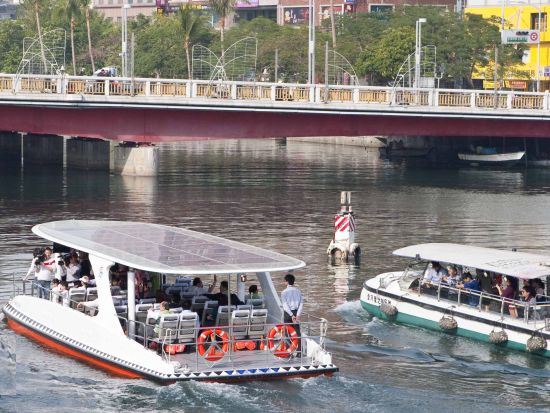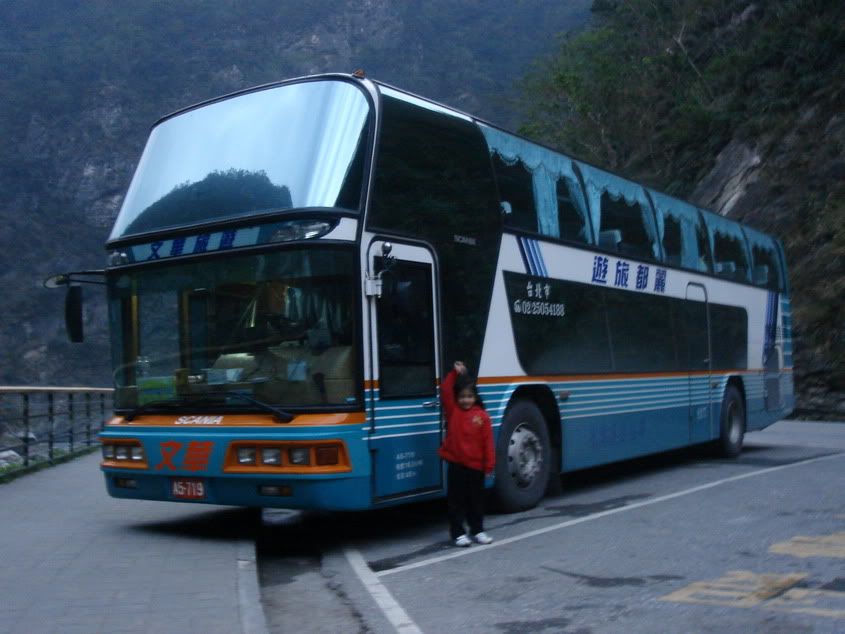 |
| The newer generation of love boat next to its soon obsolete diesel predecessor |
My previous article about the Kaohsiung Love River Boats showed that despite the solar panels having about as much use as the third eye on a peacock, their use of lithium batteries does in fact cut down on emissions significantly. Their diesel counterparts are not only uglier and older, but are also louder and more polluting. This article focuses on the financial feasibility of going electric in a commercial passenger enterprise.
Diesel vs Lithium - A Cost Comparison
The noisy, stinky, run-down diesel boats make a poor competitor to the Kaohsiung Love River's shiny new solar boats. The new fleet is silent, looks pretty, seats nearly twice as many people per trip, and understandably are selling 5000 tickets a week to the diesel’s 1800 tickets. This means that its initial investment of $250,000 USD per boat is payed back in about the same time as the older fleet, but the marketing attraction only serves to skew a direct comparison of diesel and battery power. To directly compare the diesel and battery-powered boats, this comparison will put each type in their own 7000 ticket per week market, and assume a 36 person diesel powered boat to compare with the 36 person battery-powered boat (fewer ticket sales per ride makes the comparison unfair for the current 20 person diesel boat).
Cost Comparison – Operating Costs
 |
| Prices per kWh of electricity vs kWhe of diesel, with the extreme examples of Italy and Kazakhstan for comparison. These boats pay "commercial" prices for their electricity. |
 |
| Cost of running battery powered boats is significantly lower than diesel, and still competitive in the extreme example of Italy |
Engine Efficiency (Or lack-thereof)
 |
| Combustion engines are inherently inefficient, theoretically losing around 60% of their energy to heat, combustion, pumping, and friction[5]. |
Internal combustion engines have the added inefficiency of moving parts and waste from excess heat, whereas lithium batteries have no moving parts and expel much less heat. The energy in batteries are transfered more directly into work powering the boat propellers in this case, or turning crank shafts in the case of electric cars[6].
Cost Comparison – Return on Investment
Costing $250,000USD*, the “Solar” Love Boat comes in at about 1.5 times the price of a comparatively sized diesel craft. For personal use, this is a significant and prohibitive cost difference, with the lower cost of daily use paying off the difference, albeit very slowly. However, with commercial application such as in the case of the love boat, this cost can be quickly offset by ticket sales.
The difference in operating costs may be significant to consumers, but for operations such as this that factor almost completely disappears. To put it in perspective, the difference in cost between the cheaper $1.59 USD battery-powered ride and the more expensive $4.05 diesel-powered ride can be covered by the sale of just one passenger ticket. You can see from the graph below that although operating costs add up, they are almost negligible over the time it takes to regain the cost of the boat compared to the initial investment.
 |
| With hardly any fixed costs compared to the investment, a battery- powered fleet will take about 1.5 times as long to pay off. Slower, but still a manageable time frame. |
Because of the insignificance of daily use in the cost, an investment into a 10-boat battery powered fleet will be paid off in 3 years, whereas it will take 2 years for diesel; a noteworthy gap, but hardly an insurmountable difference. This shows that although from a purely cost-saving perspective diesel will still win out, battery-powered vehicles are well within the range of being a reasonable investment that can yield financial gain.
Cost Comparison – Repairs and Replacement
Lithium Ion batteries have long been known as unstable and needing frequent replacement, but the technology has come a long way in recent years. Current EV batteries are generally stated to need replacement in about 8 years with normal use (A.K.A. daily charging). When applied to these electric boats, this leaves about 5 years of profit after they are paid off before a replacement battery is needed. In an industry such as this, most companies would replace their vehicles after about this much time anyway just to maintain a clean, professional look. The Kaohsiung City government provides a good example of this, currently retiring the old diesel boats after about 9 years of use.
 |
| Lithium ion batteries are rated to last about 8 years, giving the Love Boats plenty of time to make a profit. |
All of these figures don’t take into account the quiet ride, sleek look, and environmentally conscious attitude of the new fleet. In essence, you're paying a premium for a superior product, which could also be an argument for other electric vehicles.
A Note on Tourism in Asia
A Note on Tourism in Asia
 |
| In Asia, tour groups with set routes minimizes the effect new attractions have on the market. |
For those of you familiar with Taipei, this inelasticity is also happening in Shilin Night Market, although in the opposite direction. The entire food court area was supplanted underground, creating a smoky, stinky, miserable environment. Unfortunately the market will not react by locals shunning this abomination because it is still visited by huge crowds of Taiwanese and mainland Chinese on their packaged tours of the island.
Green technology applied to commercial tourism in The West may have a completely different and much stronger reaction because of the lack of these set routes.
Love River Boats' Future
Despite their current manifestation as more of an advertisement for Kaohsiung than as a practical application of solar power, the Kaohsiung City government has already shown that this fleet of solar boats is not going to be the end of this process. With the current fleet’s seeming success as a marketing tool, the city government is using it as a jump-off point by investing in a new fleet with a higher solar yield of 7% (instead of the current boats' 4%) of the boats’ total operating power. Hopefully, with continual upgrades these boats will eventually live up to their moniker as "solar boats" and actually run on solar power.
Conclusion - What it all means for electric vehicles
 |
| An early electric vehicle supplanted in favor of gasoline |
What this does show, however, is an implementation of a clean vehicle in a commercial capacity that pays itself off in 3 years to become a profitable enterprise. Although mass adoption of electric vehicles is still some time away, this is an excellent indication that more may follow suit. Answering how this technology can be applied to other fuel-dependent industries is still a work in progress, and will be very interesting to watch unfold.
 |
| The Nissan Leaf is the first major release of a pure EV for mass consumption |
References
[1] http://205.254.135.7/emeu/international/elecprii.html
[2] http://www.eia.gov/emeu/international/elecprih.html
[3] http://www.eia.gov/cneaf/electricity/esr/table5.html
[2] http://www.eia.gov/emeu/international/elecprih.html
[3] http://www.eia.gov/cneaf/electricity/esr/table5.html
[4] http://www.chinapost.com.tw/taiwan/national/national-news/2012/03/19/335085/CPC-Formosa.htm
[5] http://www.consumerenergycenter.org/transportation/consumer_tips/vehicle_energy_losses.html
[6] http://www.fueleconomy.gov/feg/atv.shtml
[7] http://cleantechnica.com/2012/03/08/smith-electric-vehicles-delivers-new-electric-truck-to-fedex/
*According to Kaohsiung City Shipping Co.
[5] http://www.consumerenergycenter.org/transportation/consumer_tips/vehicle_energy_losses.html
[6] http://www.fueleconomy.gov/feg/atv.shtml
[7] http://cleantechnica.com/2012/03/08/smith-electric-vehicles-delivers-new-electric-truck-to-fedex/
*According to Kaohsiung City Shipping Co.


Congratulation for the great post. Those who come to read your Information will find lots of helpful and informative tips. Compare Electricity Rates
ReplyDelete